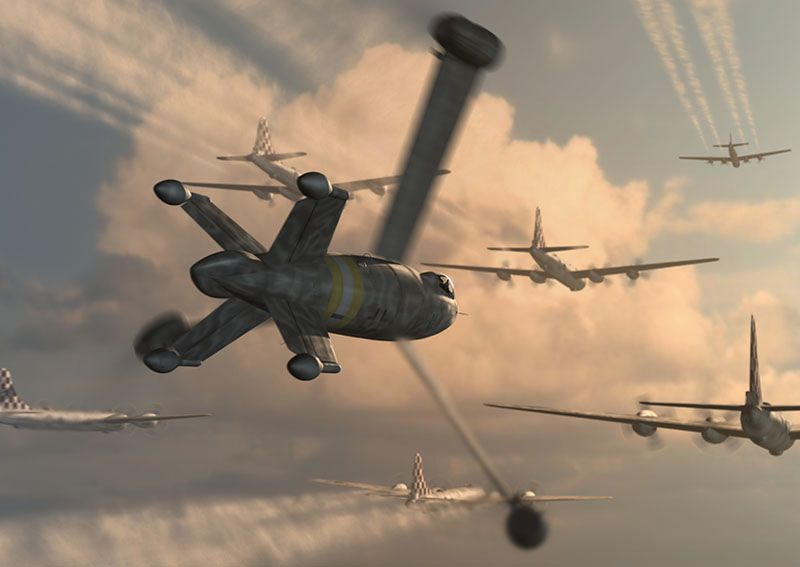Each of the three wings was tipped with a combination ramjet and 300kg thrust solid fuel Walter starter rocket
During the closing months of World War II, the Germans developed the Focke-Wulf Triebflügeljäger (power-wing fighter) as an idea for an aircraft to fend off the escalating Allied bombing raids on central Germany.
As explained by Dan Sharp in his book Secret Projects of the Luftwaffe Volume 1 Jet Fighters 1939-1945, a design for a vertical take-off tail-sitter was first patented on Sep. 10, 1938, by Otto Muck — a prolific Austrian-born inventor — but Focke-Wulf’s Triebflügeljäger married the company engineer Dr. Otto Pabst’s work on ramjets to a concept invented by Professor Erich von Holst, with input from the Aerodynamische Versuchsanstalt (AVA, one of the four predecessor organizations of the 1969 founded “German Research and Experimental Institute for Aerospace”) Gottingen-based jet intakes specialist Dr. Dietrich Küchemann.
The Second Reichswettbewerb für Saalflugmodelle, also known as the Reich Contest for Indoor Flying Models, was held in Breslau on November 20 and December 1, 1940. Von Holst, a worker at the Zoological Institute in Gottingen, entered two model ornithopters and took second place. One model was created to mimic the effect of a bird’s two wings flapping, and the other was created to mimic a dragonfly’s four-wing movements.
A 1942 paper by von Holst, Küchemann, and K. Soif that examined how von Holst’s models could be scaled up to a full-size aircraft and basically replaced the lapping dragonfly wings with two counter-rotating sets of helicopter blades was based on research surrounding this later movement.
In March 1944, Pabst presented a set of calculations describing the potential performance of his ramjet engines when mounted on the helicopter blade tips of the von Holst/Küchemann aircraft. In May, Focke-Wulf engineer Heinz von Halem worked to choose the optimal configuration for the aircraft. His focus was drawn to a cigar-shaped fuselage with three rotating wings attached either at the tip of the nose, with the pilot seated behind them, halfway back from the nose, or almost halfway along the fuselage, with the pilot seated in the nose.
By September 15, 1944, the fundamental design of the single-seater aircraft had been decided upon, and a brief preliminary description had been written. The aircraft’s cruciform tailfins were meant to rest on four 380 x 150mm outrigger wheels at each end, and a single 780 x 260mm wheel that was enclosed in a fairing at the tip of the fuselage, allowing it to sit vertically on the ground. The longest possible fuselage measured 9.15m when the mainwheel retracted into its housing during flight.

Each of the three wings was tipped with a combination ramjet and 300kg thrust solid fuel Walter starter rocket. The ramjets could be turned on and would then take control once the rockets had sufficiently accelerated the wings. The total wing area was 16.5 m2 (3 x 5.50 m2), and the largest wing diameter was 11.50 m. A total of 1,500kg of gas or liquid fuel for the ramjets was stored inside the fuselage. Armament consisted of two MK 103s with 100 rounds each and two MG 151s with 250 rounds each in the aircraft’s nose, one of each on either side of the pressure cabin cockpit. Armor protection was described as “usual fighter armor.”
On October 12, 1944, a second description was written that somewhat changed the aircraft’s dimensions: the fuselage length was raised to 9.35 meters, the wing diameter was lowered to 11.40 meters, but the wing area stayed at 16.5 meters.
Based on a description in a report by British intelligence. “In this aircraft, the normal wing is replaced by three rotating ‘wings’ or vanes each with an athodyd (Lorin duct) at the tip. The ‘pitch’ of the ‘wings’ can be adjusted by the pilot and the maximum peripheral speed which is normally used for the climb is 670ft/sec (455mph). It will be appreciated that with such an arrangement the air speed of the athodyds may be considerably greater than that of the fuselage.
“In this way, efficient operation of the athodyds can be achieved when the aircraft speed is relatively low and one of the main objections to this form of propulsion is thus overcome. The higher the forward speed of the fuselage the slower the rotation of the ‘wings’ and the smaller the difference between athodyd speed and fuselage speed.
“For take-off, the aircraft stands vertically on its tail (in which the wheels are housed) and initial rotation is imparted to the ‘wing’ assembly by three auxiliary Walter rockets incorporated in the athodyds. As soon as the peripheral speed appropriate to athodyd operation has been attained the main units are started up. During this stage, the ‘wings’ are in neutral pitch. When they are moved into fine pitch lift is imparted to the aircraft partly due to the rotation of the wings and partly due to the components of athodyd thrust parallel to the fuselage axis.
“After leveling out, the pitch is further coarsened and the speed of rotation correspondingly reduced in order to maintain a constant Mach number of 0.9 at the wing tips. At the maximum designed speed of the aircraft the wings rotate at 220rpm.”
There were six main benefits associated with the Triebflügeljäger: “1) High efficiency and low fuel consumption. 2) High ceiling. 3) No runway is required for take-off or landing. 4) Low weight. 5) Simplicity. 6) Any combustible medium (gas or liquid) which can be vaporized may be used as fuel.”
After October 1944, the project doesn’t seem to have continued.
Secret Projects of the Luftwaffe Volume 1 Jet Fighters 1939-1945 is published by Mortons Books and is available to order here.
Photo by War Thunder

